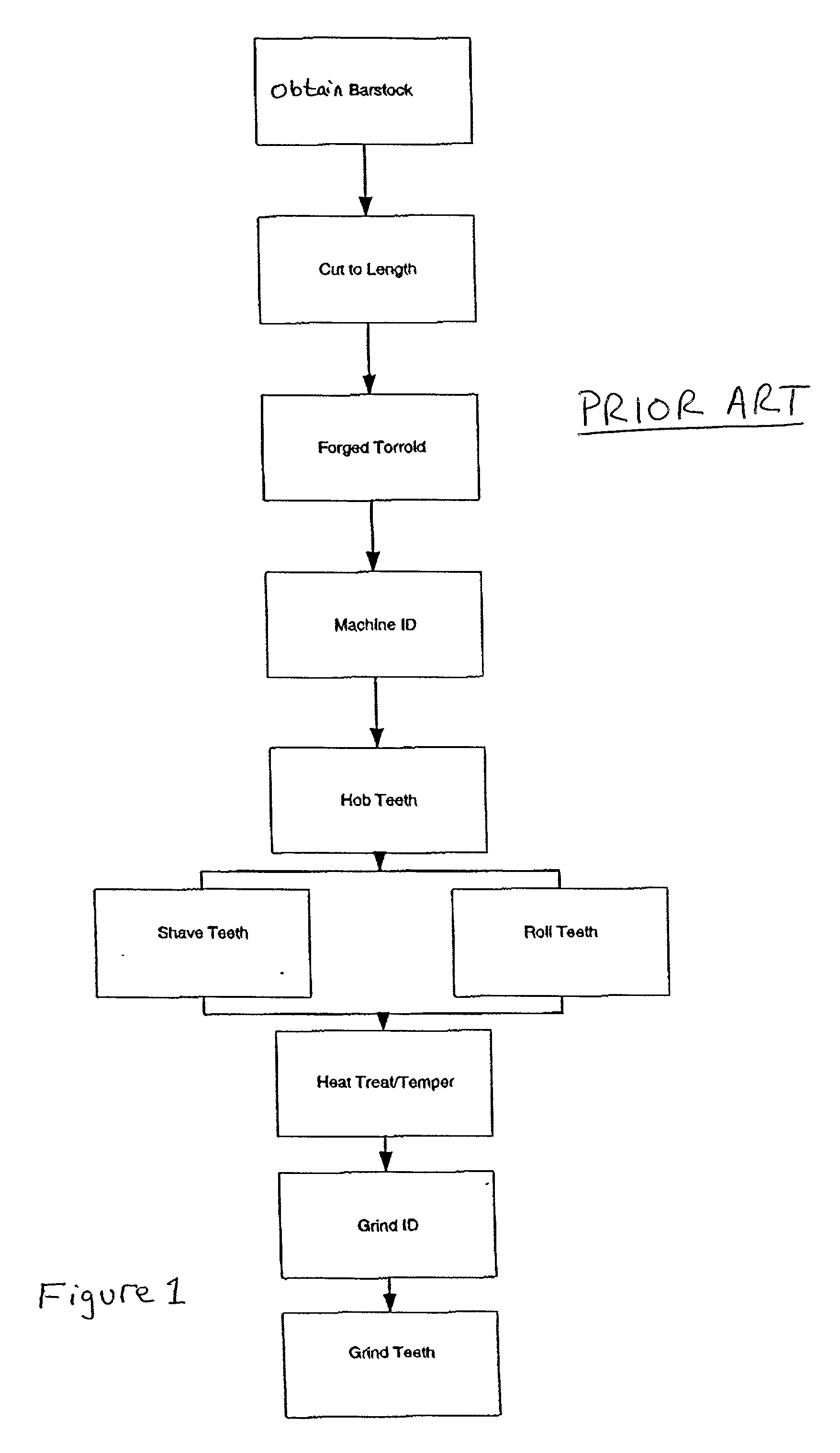[0009] A
conventional technique for producing external
helical gears is schematically shown in FIG. 1. The method includes
cutting to length wrought
steel bar stock,
forging toroidal gear blanks from the individual sections,
machining the internal
diameter,
hobbing helically disposed gear teeth on the outer surface of the gear blanks, and then either shaving or rolling the teeth to adjust the dimensions and increase the uniformity of the gear teeth. The gears may then be
heat treated and tempered to improve
hardness and, possibly, other mechanical properties. The internal
diameter is then ground.
Grinding,
honing, or lapping techniques may then be used to further improve the quality of the gear teeth.
Honing of steel gear teeth is often used to remove nicks and burrs, to improve
surface finish, and to make minor corrections in tooth shape. Lapping may be used for sets of
hardened steel gears that must run quietly.
[0010] A level of quality may be assigned to a gear based on the DIN classification
system. A classification
system for assigning a whole number grade to the level of dimensional accuracy of cylindrical gears is provided in DIN standard 3962. DIN 3962 assigns
lower grade numbers to gears having smaller deviation in dimensional characteristics, such as face width and face diameter, that may affect the gear's alignment with
mating parts. The quality grade "1" is assigned under DIN standard 3962 to cylindrical gears having the smallest deviation in those characteristics. Thus, cylindrical gears of a particular grade based on the DIN 3962 standard may be produced by setting allowable manufacturing tolerances in line with DIN standards. Those of ordinary skill may readily determine the grade number for a particular cylindrical gear under the DIN 3962 standard by measuring deviations in the relevant gear characteristics or by knowing the tolerances for those characteristics applied during gear manufacture.
[0011] One known process for manufacturing external helical gears for automotive applications from wrought
steel bar stock includes the above-described sequence of steps. A steel commonly used in that process includes, in weight percentages, 0.18-0.22 iron, 0.60-0.95
manganese, 0.15 max.
silicon, 0.35-0.75
nickel, 0.35-0.65
chromium, 0.015-0.045 aluminum, 0.15-0.25
molybdenum, and incidental impurities. As indicated in FIG. 1, gears resulting after the teeth of the hobbed gear blank are shaved qualify as grade 7 based on a comparison of the DIN 3962 standard and the dimensional deviations present in the shaved gear. If the hobbed gear teeth are rolled rather than shaved, then under the DIN 3962 standard the rolled gear typically qualifies as grade 8. The higher grade number indicates that there is somewhat more dimensional deviation in external helical gears produced by rolling.
Heat treating the hobbed or shaved gears introduces stresses that affect the dimensional variability of the gears and increases the DIN 3962 grade, usually to grade 9. In applications requiring higher dimensional accuracy and, conversely, lower alignment deviation, the heat-treated gear teeth may be honed to increase the DIN 3962 quality of the gears to about grade 7. If even greater dimensional accuracy is required for a particular application, the time-consuming step of
grinding the teeth may increase the DIN 3962 quality to grade 5-6.
[0014] In order to address the above-described needs, the present invention provides a novel method for producing gears from an iron-base metallurgical powder that is an alternative to producing the gears from wrought
bar stock. The method includes molding at least a portion of the iron-base metallurgical powder to provide a gear preform, and subsequently
sintering the gear preform to form a sintered preform. The gear preform is subsequently hot formed, and is carburized in a later step to introduce carbon into at least a surface region of the preform. The gear preform is subsequently resintered and is then cooled at a
cooling rate that provides a bainitic
microstructure in at least a surface region of the preform. If desired, the gear preform may then be shaved to adjust the dimensions and increase uniformity of the gear teeth.
[0018] The methods of the present invention may be used to form gears of any type, including, but not limited to, straight gears, helical gear,
pinion gears, ring gears, and spur gears. The present invention's methods are particularly suited to producing external gears such as external straight gears and external helical gears. Gears produced by methods according to the present invention may be of high quality, qualifying as DIN grade 5 or better under the DIN 3962 standard, immediately after a step of shaving the gear teeth and without
grinding,
honing, or other
surface finishing steps. The powder metal methods of the present invention may require fewer steps and less manufacturing cost than certain conventional methods of producing gears for like applications.
 Login to View More
Login to View More 


